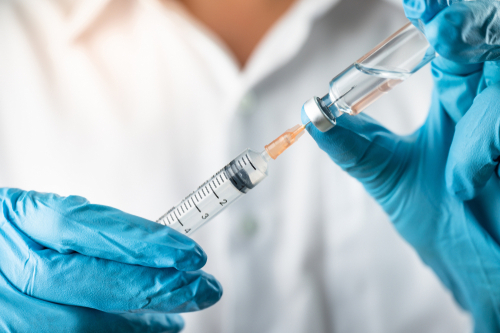
What is a vaccine?
A vaccine is a substance that is prepared from a disease-causing pathogen or organism that causes a disease or its parts or substances that replicate the organism. Once introduced into the host’s body, a vaccine provides immunity against the disease caused by the organism by stimulating the immune system to produce antibodies against it.
How do vaccines work?
A vaccine works by enabling your body’s immune system to identify and combat pathogenic organisms. This is done by introducing either weakened organisms or proteins used to identify the organisms into your body. The immune system identifies these structures known as antigens as foreign and produces antibodies to combat them. When the organism infects the body in the future, there is an aggravated response by the immune system to produce antibodies against it due to what is known as immunological memory. Immunological memory is the ability of the immune system to respond more rapidly and effectively to a previously encountered pathogen. This provides immunity against the disease.
Vaccines and herd immunity: What is the link?
When enough people in a population are protected from disease by vaccination, the chances of an outbreak are very less. There aren’t sufficient hosts for the pathogenic organism to survive in the population and the disease will die out completely. This protects others in a population as well who are not vaccinated. This includes elderly people, young children and babies as well as those with a weak or compromised immune system.
Is there a vaccine for COVID-19 yet?
It seems like we are stuck in a state of quiescence, with no end in sight. Currently, the only way to contain the virus in the absence of a vaccine is by following practices of social distancing, wearing masks and avoiding crowds along with testing and tracing of contacts. However, these methods are not fool-proof and are difficult to follow all the time.
Russia has announced the approval of its COVID-19 vaccine in August. However, whether adequate research and trials have gone into its release is still under speculation.
The United States Government has promised funding of up to ten billion dollars for a program known as the Operation Warp Speed. This aims to significantly reduce the time to develop a vaccine and complete clinical trials as well as ensure rapid production of millions of doses as soon as the FDA approval is obtained.
Promising vaccines for COVID-19 are under development in India, The United Kingdom, The United States of America and China. However, scientists have not been able to develop effective vaccines against the Coronavirus family of viruses till today. It is also still not known if these viruses can mutate to escape the body’s immune system even after vaccination.
Types of immunization: How are vaccines made?
Scientists have developed different types of vaccines and many ways of injecting antigens from organisms into the human body without causing any harm, but still stimulating the immune system:
- Live attenuated vaccines: A weaker or inactive form of viruses or bacterias are used for these vaccines. Though these antigens will not cause disease, they will stimulate the immune system to produce antibodies against them. Since these are actual live pathogens, they are very effective and provide life-long immunity. However, these vaccines cannot be offered to people with a compromised immune system such as those suffering from AIDS, for example. This is because they may cause the disease in such people. Another important factor to keep in mind is that these vaccines should always be refrigerated and maintained at the ideal temperature, to prevent them from dying.
Examples of live attenuated vaccines include the live viral vaccine known as MMR vaccine given for immunity against measles, mumps and rubella in combination and the BCG vaccine for Tuberculosis. Certain influenza vaccines are also live attenuated.
- Inactivated or killed vaccines: The pathogenic organism is killed using heat or chemicals and these dead cells are injected into the body. Even though the cells are dead, they can stimulate the immune system by means of the proteins coating their surface. Inactivated vaccines are safer to inject in immunocompromised individuals, as they pose no risk of causing disease. These vaccines can be stored in deep freezers and are generally safer.
Examples of inactivated vaccines include Injectable Polio Vaccine (IPV), Hepatitis A vaccine and the Rabies vaccine.
- Subunit vaccines: Subunit vaccines are those which are prepared using a protein or carbohydrate removed from the organism and injected to create an immune response. These vaccines are harder to prepare since the component isolated must stimulate the immune system accurately. These vaccines are very safe, with a very low risk of adverse reactions. Vaccines for Hepatitis B, Human Papillomavirus, Pertussis and Meningococci are all examples of subunit vaccines.
- Toxoid vaccines: Some organisms cause diseases in man by producing toxic compounds. These toxins are made inactive by being treated with chemical agents and then used as a vaccine. These inactive toxins are sufficient to create an immune response. Diphtheria and Tetanus vaccines are made from inactive toxins.
- Conjugate vaccines: Some bacteria, like the Haemophilus influenzae B bacteria (HiB), are coated by carbohydrates that mask the pathogen and make it difficult for the immune system to identify it as a foreign particle. This is bypassed by attaching the carbohydrate coat with known antigens. This enables the immune system to identify the coat as a target pathogen and promotes an effective immune reaction. Such vaccines, which use a known antigen tagged onto the coating of the organism are called conjugate vaccines. Another example is the Pneumococcal Conjugate Vaccine or the PCV.
- DNA vaccines: DNA vaccines are made by extracting a component of the DNA of the pathogen which is injected into the body. This DNA would instruct the immune cells to combat the antigens. They are cheap, easy to produce and are very efficient trainers of the immune system. DNA vaccines are still under research and are not ready for mass production yet.
- Recombinant vaccines: Also known as Recombinant vector vaccines, these are similar to DNA vaccines in that part of the pathogen’s DNA is inserted into the host’s cells, instructing the immune system to combat the organism. In order to insert the DNA, they use an inactivated bacterium or virus as a carrier. Currently, recombinant vaccines are being developed for Measles, Rabies and HIV.
Vaccination for babies and children during COVID-19: What is recommended?
This is a common query for parents and has been addressed by the World Health Organisation (WHO). WHO has stated that irrespective of the global pandemic, it is still important for babies to get vaccinated in the second, fourth, sixth, twelfth and thirteenth months. Most children do not get severely ill from a Coronavirus infection, but vaccine-preventable diseases can be very dangerous if contracted. So, it is best to stick to your child’s vaccination schedule and avoid missing their shots.


